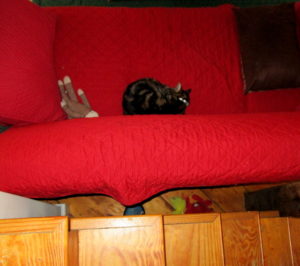 As the days get longer, Bamboo the cat invariably succumbs to cabin fever. This year, I’m convinced that the wild fluctuations in the winter weather have exaggerated this effect. He’s 10 now and the complex internal algorithm he uses to decide whether to go outdoors or stay in is another variable he considers. However, he and I differ on the method for collecting sufficient data about temperature, humidity, wind speed, depth of any snow or puddles, the kinds of wildlife, dragons, impending nuclear holocaust or other factors that might influence his decision. He prefers to get me to open the door to commence his data collection by issuing strident vocal commands. Once I open it—and I inevitably do because he has what a musician friend refers to as an “unfortunate” voice–he stands on the threshold of the open door. This goes on until he makes up his mind to go out or stay in. Or more often, I get fed up and make the choice for him. Every time he does this, I can hear my mom yelling at us kids, “Either go out or stay in, just make up your mind!” Depending on the season, she would add, “Don’t let the cold air in!” Or “Don’t let the bugs in!”
As the days get longer, Bamboo the cat invariably succumbs to cabin fever. This year, I’m convinced that the wild fluctuations in the winter weather have exaggerated this effect. He’s 10 now and the complex internal algorithm he uses to decide whether to go outdoors or stay in is another variable he considers. However, he and I differ on the method for collecting sufficient data about temperature, humidity, wind speed, depth of any snow or puddles, the kinds of wildlife, dragons, impending nuclear holocaust or other factors that might influence his decision. He prefers to get me to open the door to commence his data collection by issuing strident vocal commands. Once I open it—and I inevitably do because he has what a musician friend refers to as an “unfortunate” voice–he stands on the threshold of the open door. This goes on until he makes up his mind to go out or stay in. Or more often, I get fed up and make the choice for him. Every time he does this, I can hear my mom yelling at us kids, “Either go out or stay in, just make up your mind!” Depending on the season, she would add, “Don’t let the cold air in!” Or “Don’t let the bugs in!”
Although some human supremacists may accuse me of anthropomorphism when I compare these feline and human behaviors, I don’t see it that way. In defense of the animals and humans who do this, stopping to think before you act confers a survival advantage. Animals who don’t collect, then analyze data in terms of any costs or benefits before racing out of a secure location into an unknown space are more vulnerable than those who get the lay of the land first. So are people. True, we might not be on the lookout for potential prey or predators. But as kids, we might be on the alert for siblings or playmates waiting to ambush us, or the sound of the approaching ice cream truck. As adults we might be more inclined to go out to get the mail if the ice on the walk has melted, and less inclined to leave our homes if our meddlesome neighbor is working in his yard. I like to think that most free-roaming wild and domestic animals and people of all ages also are smart enough to stop, look, and listen before crossing streets, roads, highways, and railroad tracks. However, we all know that such is not the case.
Cabin fever also causes Bamboo to increase his repertoire of games, most of these guaranteed to bait the dogs in some way. For a while he resurrected the Cleopatra Game in which he rolls himself up in the cotton rug in my office. Once inside the rug, he waits for an unsuspecting dog to walk by the end of the rug. When one does, a feline front leg shoots out with the speed of a striking cobra, he whaps the dog with his paw, then retracts it before the dog knows what happened. He used to do this to me too, until the day his sneak attack caused me to drop a full mug of coffee on the floor in front of him. I believe his mad dash through the coffee and my energy-intense response convinced him that, unlike the often clueless dogs, Mommy Dearest wasn’t a safe target this game.
This year’s new cabin fever game drove me crazy for a while. I knew it reminded me of some wild animal behavior used for a completely different purpose, but I couldn’t remember what. Like all Bam’s games, the new one is simple but requires a certain amount of strategic planning.
The cast of characters:
The innocent victims sleeping in their drawer in my office
The Instigator
The scene: I live in an old house with a narrow, mostly open staircase that terminates in my second-floor office. The bottom of the stairs informally separates the living room from the kitchen and Great Area. I call it the Great Area because a lot goes on there, not because it’s that great. Because the living room is long and narrow, the only place the couch fits is next to the stairs.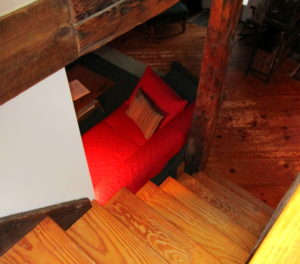 Somewhere along the line, the dogs began jumping from one of the middle steps onto the couch instead of going all the way down the stairs:
Somewhere along the line, the dogs began jumping from one of the middle steps onto the couch instead of going all the way down the stairs: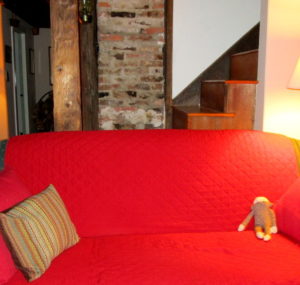
From the couch, they would jump to the living room floor, and run past the bottom of stairs and into the Great Area or kitchen. Perhaps they decided it was faster or more fun to get downstairs that way. Eventually Ollie started doing this every time he came down the stairs whereas his more polite and less exuberant mother might or might not for reasons I’ve yet to determine.
Enter the cat vibrating with cabin fever energy and looking for a place to dissipate it. Perhaps by a process of trial and error I missed while working or otherwise involved, he discovered that if he stretched himself full-length and crammed his upside-down body in the space where the seat of the couch meets the back, the dogs couldn’t see him as they came down the stairs. Or if they did, by then it would be too late because the unsuspecting dog already would have jumped from the step. When a dog did jump, Bam would lunge upward and whap the dog with his front paws from below. As cat and dogs have honed their skills, they’ve adapted the game accordingly.
It took me a while, but I eventually realized that Bam’s behavior represented the solitary domestic feline version of a group hunting strategy that lionesses sometimes use to catch dangerous prey such as cape buffalo or wildebeest. Each animal in the cooperative hunting group has a specific role and success depends of all of them doing their jobs. In the specific case that Bam’s behavior caused me to recall, all except one lioness approached the herd from the sides and back. In addition to unsettling the herd, it caused them to bunch together and eventually stampede. While her teammates accomplished this, the other lioness crawled on her belly through a ditch that initially paralleled the herd but ultimately positioned her in front of it. When the panicked herd leaped the ditch, she pulled a wildebeest down into the ditch and pinned it. In no time rest of the team joined her to complete the kill and feed.
Does Bamboo carry remnants of this behavior in his ancient feline predatory behavior database? He might. For all I know, he periodically may use his adapted solitary version when dispatching larger prey (or even predators threatening him) in addition to playfully harassing the dogs.
Stage two of Bam’s new game involves either the attacked dog or both dogs going after him in hot pursuit with much faux furious barking and snarling. If and for how long this goes on depends on same old, same old: the results of an internal cost-benefit analysis. If this occurs at the end of the day when they know their dinners loom on the horizon, these high-speed chases that position Bam as the mock-prey and the dogs as determined (and possibly vengeful) mock-predators go no farther than the kitchen. Once there, good behavior magically resurfaces and reigns. (Mommy Dearest gets grumpy when real or mock battles occur in her kitchen.)
My guess is that, were one inclined to compare human and animal predator and prey hunting and play strategies, you would find enough similarities that it would be difficult to make the argument that human displays represent the function of a superior brain. The same erratic protean displays used by predator-prey species in attempts to catch or evade capture occur in battle and on all sorts of athletic fields. The tactics used by solitary human pursuits that also show up in their play mimic those used by solitary animals engaged in comparable activities.
In no way do I mean to suggest that human brains, in general, are inferior to animal ones, although sometimes people do things that make wonder. But the more I know about human and non-human animal behavior, the more I believe that H. sapiens’s success has little to do with our unique approach to problem-solving. It seems far more likely that we owe much of our success to the behavioral legacy we inherited from animals. Where we excel in is our ability to borrow and adapt the animal behavioral repertoire to enhance our own well-being. It’s our ability and willingness to observe and adapt what animals do, including play, to survive in all kinds of environments that made us great. The day we lose an appreciation for that connection with nature will be a sorry one for all of us.
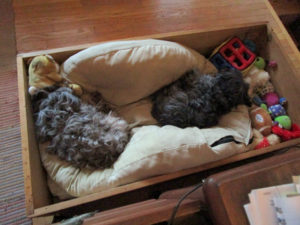
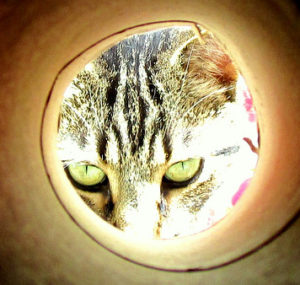
Thank you for your support! We love you too!